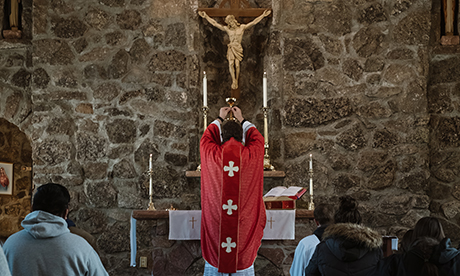The solution has been found to save the Church from its predicted demise, we need more “sacrality”, a return to the Traditional Latin Mass, and a “more traditional discourse” on social issues.
Then all will be right with the Catholic world…
Obviously, I’m just caricaturing.
But this was the tenor of some of the comments that began circulating after the success of the traditionalist Chartres Pilgrimage over Pentecost weekend and the publication of La Croix’s survey of young Catholics going to World Youth Day, who indicated enthusiasm for more classical forms of their religion.
The truth is, for the past 25 years we’ve been hearing the same thing, and in almost the same words…
One generation, the “conciliarists” or the famous “Vatican II generation”, has failed to maintain Catholicism at its current level.
And so we need to return to more traditional celebrations, even in Latin, and to a more interior, less “social” practice of the Catholic faith.
Movements encouraged under the pontificate of John Paul II
Between 1990 and 2000, this same Vatican II generation was already being pitted against what was then seen as the “future” of the Church in France – groups such as the Saint-Jean Community and the Community Beatitudes, which were more traditional in their dress, theology, and liturgical practices.
It is not a matter of criticizing these movements today.
But they were presented as the solution at one time, and now we must admit that they were no more so than other groups.
In some cases, they have even been painfully called into question because of their abusive behaviour.
Meanwhile, Catholics of the Vatican II generation – those “conciliarists” who are accused of being the source of all evils – are mostly past retirement age.
Most of them have already died, while those still alive have not been at the helm of the Church for a quarter of a century.
So, if we really must point the finger at someone, we need to be consistent and say it’s “the fault” of all these movements born with John Paul II.
An anthropological rupture
Except that doesn’t make any sense at all!
It’s really nobody’s “fault”… or at least, not in that way.
The obsession to blame one segment of the Catholic Church – and let’s face it, over the last thirty years, the conciliarists have taken their share of it – is the best way of refusing to see the problem.
The Church should welcome those Catholics who have a rather traditional outlook and remain faithful to regular religious practice.
But we must admit that they do not represent the French population as a whole, and realize that French Catholicism is in danger of becoming a “monocolored” minority.
The culprit, if there is one, is the considerable anthropological rupture we experienced from the 1950s onward, which completely overturned our relationship with the Divine, the human body and the institutions.
The model of an ecclesial institution focused solely on liturgical celebrations on Sundays and the major moments in life (birth, marriage, death) no longer holds up in our secularized society.
Or, it can only attract a small part of the population.
The vast majority of young people – and the not-so-young for that matter – don’t fit in anymore.
This does not mean that it isn’t important for Christianity to still find a means of expression, of transmission, and that the Gospel continues to be read and prayed.
On the contrary!
But without a doubt, we need to accept other ways of praying, gathering, coming together and getting involved.
Rather than embroiling ourselves in mutual and sterile accusations, we need to be creative – as Benedict XVI theorised – and dare to be different, diverse, without a single model, putting aside labels such as “reactionary” or “progressive” Catholics.
Because what is at issue here? Having a Church that “works” well or one whose members are collectively more faithful to the Gospel?
- Isabelle de Gaulmyn is a senior editor at La Croix and a former Vatican correspondent.
